The Featured Creatures collection provides in-depth profiles of insects, nematodes, arachnids and other organisms relevant to Florida. These profiles are intended for the use of interested laypersons with some knowledge of biology as well as academic audiences.
Introduction
The bluegrass billbug, Sphenophorus parvulus Gyllenhal, is a weevil that commonly infests cool season turfgrasses, especially Kentucky bluegrass, Poa pratensis L. (Figure 1). More than 64 Sphenophorus species occur in the United States. Florida contains about 25 of them, including Sphenophorus apicalis LeConte, Sphenophorus cariosus Oliver, Sphenoplwrus inaequalis Say, Sphenoplwrus mininms Hart, and the hunting billbug. Sphenoplwrus venatus vestitus Chittenden (Peck and Thomas 1998; Woodruff 2001; Huang and Buss 2009). Larval and adult billbugs can be damaging in residential lawns, golf courses, or orchard grasses.
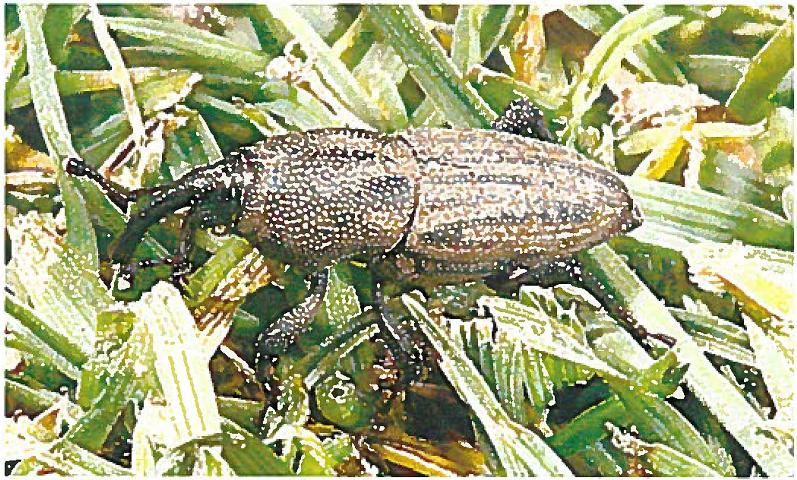
Credit: David J. Shetlar, Ohio State University
Synonymy
Calendra parvula Gyllenhal 1838 (Vaurie 1954)
Calandra parvulus Gyllenhal 1838 (Schellenberg and Clairville 1789 cited by Kuhn et al. 2013)
Sphenophorus parvulus Gyllenhal 1838 (Vaurie 1951, ICZN 1959)
Distribution
Splzenophorus parvulus is widely distributed within the United States and Canada (Vaurie 1951; Johnson-Cicalese et al. 1990; Watschke et al. 1995). Vaurie (1951) reported the distribution of Sphenophorus parvulus to include Arkansas, Colorado, Florida, Georgia, Illinois, Iowa, Kansas, Kentucky, Minnesota, Missouri, New York, and Texas, and also in Ontario, Canada. It has also been reported from Utah and Washington (Tashiro and Personius 1970), and in Nebraska (Kindler and Spomer 1986; Bruner 1890) (Figure 2).
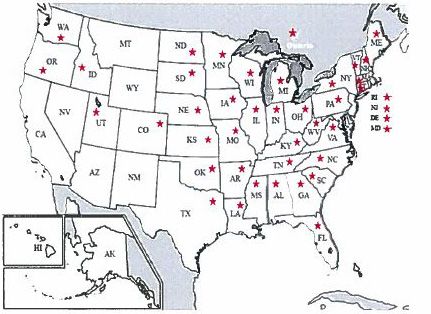
Credit: Map modified from General Turf and Insects - Stem and Thatch Pests by David J. Shetlar, Ohio State University.
Description
Sphenoplwrus parvulus eggs are bean-shaped (oblong) and are off-white or cream-colored (Figure 3). Eggs are 1.4 to 1.6 mm (~1/16 in) long and 0.6 mm wide (Kindler and Spomer 1986).
Larvae are soft bodied, legless, off-white in color, and have a distinctly sclerotized (hardened) head capsule (Watschke et al. 1995). The head capsule color varies from yellowish after hatching to dark red or brown when older (Figure 4). Larvae range from 1.2 mm (< 1/16 in) (first instar) to 8 mm (1/3 in) in length (fifth instar). The fifth instar becomes a pre-pupa, and actively constructs an earthen cell in which to pupate.
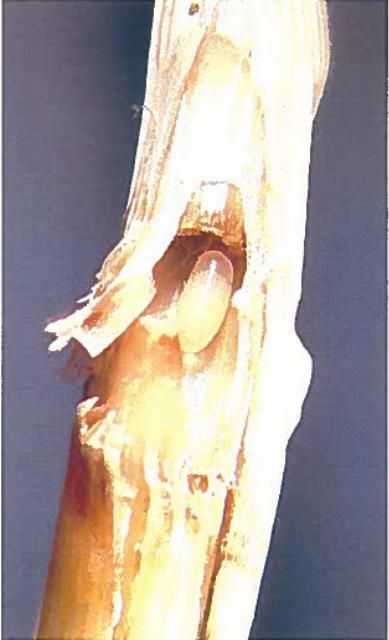
Credit: David J. Shetlar, Ohio State Univeristy
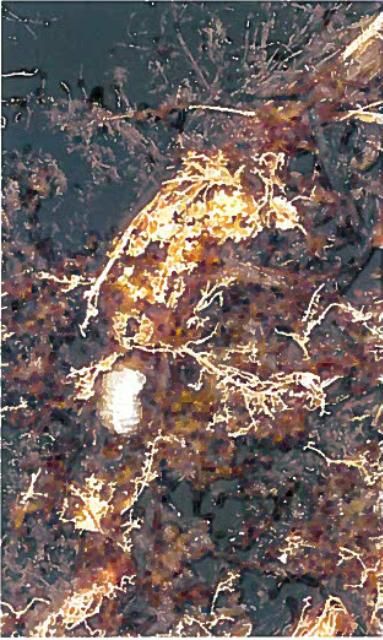
Credit: David J. Shetlar, Ohio State University
Pupae (Figure 5) are soft and initially off-white in color and then turn rusty brown just before the adult emerges. The pupa has the distinctive snout visible, but the wings and legs are wrapped around the middle of the body. Pupae range from 5.5 to 10 mm (~1/4–2/3 in) in length (Satterthwait 193Ia).
Adult Sphenophorus parvulus (Figure 1) are distinguished by their typical snouts and for their brown-black color with uniformly small pits in the pronotum. Teneral (newly emerged) adults look rusty brown in color but darken when sclerotized. Adult body lengths range from 5 to 8 mm (~1/8–1/3 in); mean length is 7.6 mm for females and 6.9 mm for males. The elytra (wing covers) are characterized by punctate furrows forming striated lines similar to parallel chains (Vaurie 195I; Watschke et al. 1995). The antennae are geniculate (elbowed) and arise from the base of the snout.
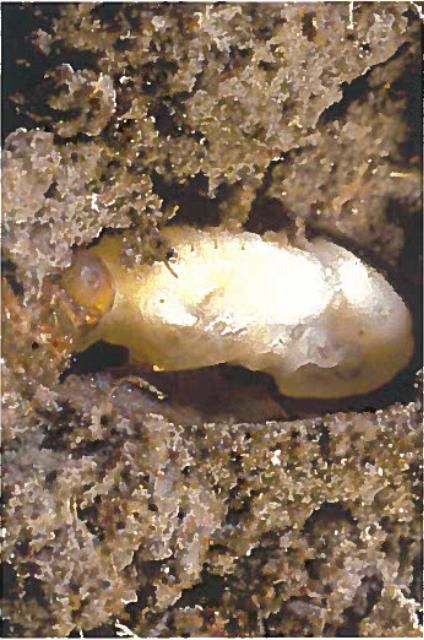
Credit: David J. Shetlar, Ohio State University
Life Cycle and Biology
Sphenophorus parvulus has one to two generations per year in Kentucky, Ohio, West Virginia, and Pennsylvania, but has two or more generations in warmer regions (Figure 6) (Kindler and Spomer 1986). The life cycle of Sphenophorus parvulus may be more synchronized in the northern US than in the South due to consistent seasonal changes. The following life cycle is based on studies in Nebraska (Kindler and Spomer 1986). Sphenophorus parvulus adults begin emerging from their overwintering sites (beneath dead leaves, under rocks, sticks, and litter, for example) in the spring when the soil temperature (2.5 cm (1 in) deep) reaches 18°C to 20°C (64.4°F to 68°F).
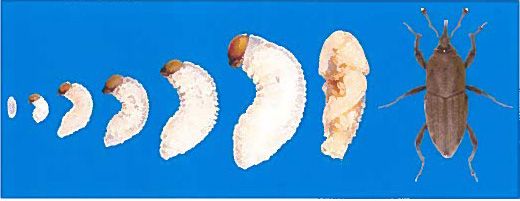
Credit: David J. Shetlar, Ohio State University
After emergence, adults search for host plants and start feeding. From late April through May, mated females chew holes in the base of grass stems into which they insert one to three eggs. Each female lays about 255 eggs over a three-month period, but most egg laying occurs in the first month. Eggs can be found from May to September with a peak oviposition period in May and June in Nebraska (Kindler and Spomer 1986). At 21°C (69.8°F) the incubation period for eggs ranges from six to 11 days.
First generation larvae finish development by the end of June and new adults begin to appear in July. These adults often lay eggs that can produce second generation adults in August until early October. Only Sphenophorus parvulus adults can overwinter, in contrast to the hunting bill bug, Sphenophorus venatus vestitus, which can have multiple life stages overwinter or even remain actively feeding.
Larvae begin feeding inside grass stems immediately after hatching, producing powdery frass that is visible if the stems are cut. Large larvae (third instar) exit from the grass stem to the soil where they feed on roots and rhizomes (Kindler and Spomer 1986). Larval development ranges from 23 to 60 days, depending on temperature (Vaurie 1951; Watschke et al. 1995). Pupae are found in the soil close to the host plant, 2 to 5 cm (3/4 to 2 in) below the surface. The pupal period ranges from eight to ten days (Satterthwait 1931). Finally, a new generation of adults emerges and the life cycle repeats.
Hosts
Sphenophorus parvulus has become a serious pest of Kentucky bluegrass, Poa pratensis L., and corn, Zea mays L. This insect also attacks other grasses including perennial ryegrass, Lolium perenne L.; tall fescue, Festuca anmdinacea Schreb; barley, Hordeum vulgare L.; wheat, Triticum aestivum L; rye, Secale cereal L.; Virginia orchardgrass, Dactylis glomerata L.; and bentgrass, Agritis spp. (Tashiro and Personius 1970; Johnson-Cicalese 1990).
Economic Importance
According to Haydu et al. (2008), the economic value of the turfgrass and lawncare industries in the United States are significant. In Florida, for example, turfgrass is part of the residential, commercial, and recreational landscape including golf courses. Therefore, any damage caused by pests in turfgrass, lawns, and golf courses will have a negative economic impact.
High populations of Sphenophorus parvulus can kill large areas of grass. Residential home lawns, commercial sod fields, and golf courses planted with susceptible turfgrass species are affected by this insect pest. Lawns can provide benefits to the landscape, environment, and homeowners. Benefits of lawns include increasing aesthetics (look) that increases the economic value of landscape, improvements of recreational areas, but also results in reduction of pollution and prevention of soil erosion. Direct and indirect damage caused by Sphenophorus parvulus on lawns and golf courses sometimes necessitate control treatments and lawn replacement, which affect the economy of homeowners and golf courses.
Damage
Both Sphenophorus parvulus adults and larvae feed on or in grass stems, causing serious damage. The severity of damage depends on the size of the insect population and the overall health of the infested plants.
Larval stem boring and root feeding reduce or prevent the movement of nutrients in the grass and can cause plant death (Vaurie 1951). In Kentucky bluegrass, association between the number of larvae and live stems was correlated (Kindler et al. 1983). Damage is more common in newly established lawns. Damage symptoms are characterized by wilting and death of small, scattered patches in the lawn (Figure 7). Stems affected by Sphenophorus parvulus break off easily and are filled with sawdust-like frass (Figure 8). Feeding damage is more evident when soil moisture and soil fertility are low. In addition, secondary damage can occur from the infection of pathogenic bacteria and fungi present in the environment. According to Shetlar (1995), the damage is often confused with white grub or chinch bug damage, or with various grass diseases.
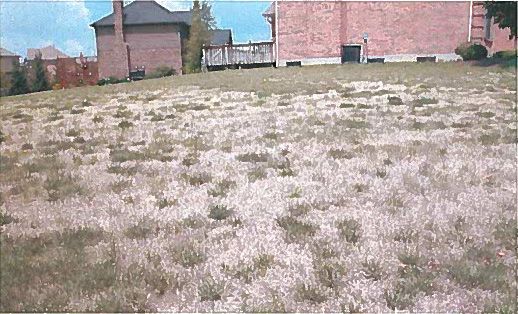
Credit: David J. Shetlar, Ohio State University
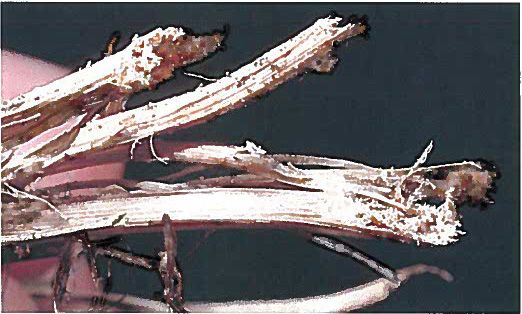
Credit: David J. Shetlar, Ohio State University
Management
Several tactics that can be used to manage Sphenophorus parvulus include cultural practices, use of biological control agents, application of insecticides, and use of resistant turfgrass cultivars as components of an integrated pest management (IPM) program. Insecticides should be applied after other control tools have been used if the insect population has increased.
Monitoring
Monitoring is the first strategy to detect pest populations and make control decisions. Pitfall traps (Figure 9) are useful tools for monitoring adult activity. Standard plastic cups (200 ml or larger) can be used to capture and sample surface-dwelling insects including adult billbugs. The container is buried in the ground and soapy-water (approximately 50 to 100 ml) or ethanol (75%) is added to prevent escape. Traps can be checked twice per week or more frequently when there is heavy rain.
Early detection of overwintered adults in spring is important to establish a control strategy before Sphenophorus parvulus reaches a high population density. According to Buss and Unruh (2005), the aesthetic threshold for Florida lawns corresponds to about six billbugs per 0.09 m2 (1 ft2). In addition, Buckley et al. (2010) estimated that seven to ten billbugs per pitfall trap (using 473 ml cups) every 3 days indicates the need for a preventive insecticide treatment to control the adults.
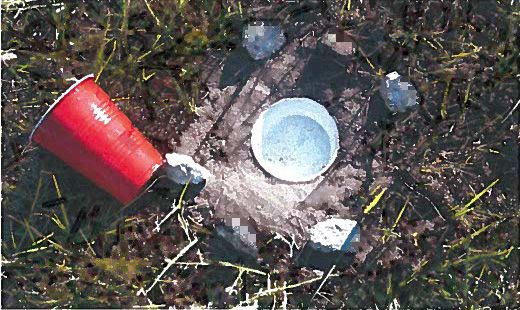
Credit: Luis F. Aristizábal, University of Florida.
Cultural Control
Selection of resistant turfgrass cultivars is a cultural practice for long-term control. There are some endophytic fungi associated with some turfgrass cultivars that provide resistance to Sphenophorus parvulus attack (Richmond et al. 2000). Fescues and perennial ryegrasses are highly resistant to this insect pest (Brandenburg and Freeman 2012). The level of susceptibility for Sphenophorus parvulus differs among Kentucky bluegrass cultivars. According to Ahmad and Funk (1982), Kenblue, Fl 757, F353, and Princenton 104 are cultivars that have shown low damage and low number of larvae per area. In addition, Reveille is a hybrid between Texas bluegrass (Poa araclmifera Torr) and Kentucky bluegrass (Poa pratensis L.); it is less preferred by Sphenophorus parvulus and has higher tolerance to this pest (Reinert et al. 2006). Populations of other billbugs such as Sphenophorus venatus vestitus can be reduced by using less susceptible cultivars and endophytic turfgrasses in warm regions like Florida (Huang and Buss 2013).
Healthy, well-nourished, and watered grasses can be more tolerant to damage and help maintain low populations of Sphenophorus parvulus. Larvae emerging from stems to feed on the crowns and roots may drown by irrigation and also be exposed to natural enemies.
Biological Control
Adult and larval ground beetles (Coleoptera: Carabidae) are known predators of billbugs (Bruner 1890). Satterthwait (1931b) reported an egg parasitoid, the wasp Anaphes (Anaphoidea) (Patasson) calendrae (Gaham) (Hymenoptera: Mymaridae). This parasitoid was introduced to Hawaii as a biological control agent of sugar cane borer, Rhabdoscelus obscurus (Boisduval) (Coleoptera: Curculionidae) in 1928 (Williams 1929) and a second introduction was conducted directly against Sphenophorus spp. in 1963, where billbugs had become established. However, evidence of the wasp's success at suppressing billbug numbers or damage is lacking (Beardsley 2000).
The entomopathogenic nematodes Steinernema carpocapse Weiser (Rhabditida: Steinemematidae) and Heterorhabditis bacteriophora Poinar (Rhabditida: Heterorhabditidae) have been effective as biological control agents against Sphenophorus parvulus larvae and adults, respectively (Watschke et al. 1995; Georgis et al. 2006). Steinemema carpocapsae and Heterorhabditis bacteriophora showed 78% and 74% control, respectively, against larvae under field conditions in Ohio (Georgis and Poinar 1994).
The entomopathogenic fungus Beauveria bassiana (Balsamo) Vuillemin (Hypocreales: Clavicipitaceae) naturally infects Sphenophorus parvulus adults, but its effectiveness is also unknown (Buckley et al. 2010). However, Saliz et al. (2014) reported partial control of billbugs in the field by applying Beauveria bassiana. Increasing irrigation on infested turfgrass in the spring could enhance fungal infection (Kuhn et al. 2013).
Chemical Control
An insecticide can be applied when the desired life stage is present, which can only be known by monitoring. Contact insecticides can reduce adult numbers to minimize stem feeding and egg-laying activity (Brandenburg and Freeman 2012). Plant-systemic insecticides are more effective against the stem-boring and root-feeding larvae. All insecticide applications must be conducted according to the product's label.
Selected References
Ahmad S, Funk R. 1982. Susceptibility of Kentucky bluegrass cultivars and selections to infestations of and injury by the bluegrass billbug (Coleoptera: Curculionidae). New York Entomological Society 90: 31–34.
Beardsley JW. 2000. The introduction and establishment of Anaphes (Potasson) calendrae (Gaham) in Hawaii (Hymenoptera: Mymaridae). Proceedings of the Hawaiian Entomology Society 34: 189–191.
Buckley RJ, Koppenhofer AM, Tirpak 5. 2010. An integrated approach to insect management in turfgrass: Billbugs. Fact Sheet FS1015, Cooperative Extension. The State University of New Jersey.
Brunner L. 1890. Report on Nebraska insects, pp. 95–106. In Report of the observations and experiments in practical work of the division. US Department of Agriculture, Washington, DC.
Buss EA, and Unruh JS. 2005. Insect management, pp. 120–130. In Trenholm LE, Unruh JB. 2005. The Florida lawn handbook, best management practices for your home lawn in Florida. Third Edition. University Press of Florida. University of Florida, Institute of Food and Agricultural Sciences. 172 pp.
Georgis R, Poinar Jr., GO. 1994. Nematodes as biopesticides in turf and ornamentals. In Leslie A. (Ed.), Integrated Pest Management for Turf and Ornamentals. CRC Press, Boca Raton, FL, USA, pp. 477–489.
Georgis R, Koppenhofer AM, Lacey LA, Belair G, Duncan LW, Grewal PS, Samish M, Tan L, Torr P, van Toi RWHM. 2006. Successes and failures in the use of parasitic nematodes for pest control. Biological Control 38:103–123.
Haydu JJ, Hodges AW, Hall CR. 2008. Estimating the economic impact of the US golf course industry: challenges and solutions. Horticultural Sciences 43: 759–763.
Huang T, Buss EA. 2009. Billbug (Coleoptera: Curculionidae) species composition, abundance, seasonal activity, and developmental time in Florida. Journal of Economic Entomology 102: 309–314.
Huang T, Buss EA. 2013. Sphenophorus venatus vestitus (Coleoptera: Curculionidae) preferences for Bermudagrass cultivars and endophytic perennial ryegrass overseed. Florida Entomologist 96: 1628–1630.
International Commission on Zoological Nomenclature, (ICZN). 1959. Opinion 572. The Bulletin of Zoological Nomenclature 17:112–116.
Johnson-Cicalese JM, Wolfe GW, Funk CR. 1990. Biology, distribution, and taxonomy of billbug turf pests (Coleoptera: Curculionidae). Environmental Entomology 19:1037–1046.
Kindler SD, Spomer SM. 1986. Observation of the biology of the bluegrass billbug, Sphenophorus parvulus Gyllenhal (Coleoptera: Curculionidae), in an eastern Nebraska sod field. Journal of the Kansas Entomological Society 59: 26–31.
Kindler SD, Spomer SM, Kinbacher EJ. 1983. Further host range studies on the bluegrass billbug, Sphenophorus parvulus Gyllenhal (Coleoptera: Curculionidae). Environmental Entomology 12: 528–530.
Kuhn WR, Youngman RR, Wu S, Laub CA. 2013. Ecology, taxonomy, and pest management of billbugs (Coleoptera: Curculionidae) in orchardgrass of Virginia. Journal of Integrated Pest Management 4: 1–5.
Peck SB, Thomas MC. 1988. A distribution checklist of the beetles (Coleoptera) of Florida. Arthropods of Florida and Neighboring Land Areas. Vol 16. Florida Department of Agriculture and Consumer Services, Gainesville, FL.
Reinert JA, Read JC, McCoy JE, Heitholt JJ, Metz SP, Bauernfeind RJ. 2006. Susceptibility of Poa spp. to bluegrass billbug, Sphenophorus parvulus. International Turfgrass Society Research Journal 10: 772–778.
Richmond DS, Niemczyk HD, Shetlar D. 2000. Overseeding endophytic perennial ryegrass into stands of Kentucky bluegrass to manage bluegrass billbug (Coleoptera: Curculionidae). Journal of Economic Entomology 93: 1662–1688.
Saliz T, Love SL, Bechinski EJ. 2014. Controlling billbug grubs in lawns. Idaho Green Thumb How-To's. University of Idaho Extension CIS 1204.
Satterthwait AF. 1931a. Key to know pupae of the genus Calendra, with host-plant and distribution notes. Annals of the Entomology Society of America 24: 143–172.
Satterthwait AF. 1931b. Anaphoidea calendrae Gahan, a mymarid parasitic of eggs of weevils of the genus Colendra. Journal of the New York Entomological Society 39: 171–190.
Shetlar DJ. 1995. Billbugs, pp. 254–262. In: Watschke TL., Dernoeden PH., Shetlar DJ. (eds.), Managing Turfgrass Pests. Lewis Publishers, Boca Raton, FL, 361 pp.
Shetlar DJ, Silox D, Gibb TJ. 2012. Billbugs, pp. 16–18. In Brandenburg RL, Freeman CP. 2012. Handbook of turfgrass insects. Second Edition. Entomological Society of America. Lanham, MD., USA. 136 pp.
Tashiro H, Personius KE. 1970. Current status of the bluegrass billbug and its control in western New York home lawns. Journal of Economic Entomology 63: 23–29.
Vaurie P. 1951. Revision of the genus Calendra (formerly Sphenophorus) in the United States and Mexico (Coleoptera: Curculionidae). Bulletin of the American Museum of Natural History 93: 33-186.
Vaurie P. 1954. New Species of Colendro from Mexico, with Notes on Others (Coleoptera, Curculionidae). American Museum Novitates, Number 1681: 1–8.
Watschke TL, Dernoeden PH, Shetlar DJ. 1995. Managing turfgrass pests, CRC Boca Raton, FL. pp. 254–262.
Williams FX. 1929. The introduction of Anaphoidea calendroe Gahan in to Hawaii as possible eggs parasitoids of our sugar cane beetle borer, Rhabdocnemus obscurus (Boisd.). Hawaii. Planters' Rec. 33: 29–33.
Woodruff RE. 2001. Hunting billbug, Sphenophorus venatus vestitus Chittenden. Featured Creatures EENV-207, May 2001. Entomology & Nematology Department, IFAS Extension, University of Florida.